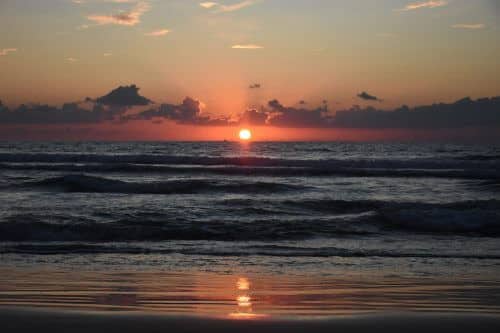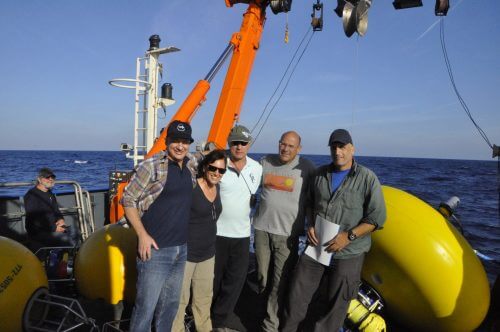After a successful one-year pilot, Bar-Ilan University and the Institute for the Study of Seas and Lakes in Israel are currently launching the first marine station for the study of the deep sea off the coast of Israel, 50 km from Haifa. The station will enable monitoring of environmental changes in the open sea that may be caused by offshore gas drilling and the functioning of the 'marine biological pump' under conditions of global warming. The initial findings raise the possibility of transporting organic carbon to storage on the seabed, in connection with increased biological activity, as well as with winter storms

These days, Bar-Ilan University, the Institute for Seas and Lakes Research in Israel and researchers from other universities are marking one year since the installation of the deep sea research station. DeepLev is a permanent marine research station, the first of its kind in this region, and it was placed off the coast of Israel, 50 km west of Haifa. The station is anchored to the seabed at a water depth of 1500 m, and has a large number of the most advanced and state-of-the-art measuring devices, spread along a cable from the bottom to almost the sea level, which enables a continuous comprehensive study of the physical and ecological system in the Eastern Mediterranean. The project is headed by Prof. Yishai Weinstein and Prof. Ilana Berman-Frank of Bar-Ilan University and Prof. Barak Harut and Dr. Timor Katz of the Israel Seas and Lakes Research. Researchers from other institutions (the Hebrew University, Tel Aviv University and the Geological Institute) are partners in the project, and it is a center of activity for researchers from a variety of fields in marine sciences. The station is of particular importance, due to the need to understand the response of the sea to pollution events, for example in connection with the production wells and gas rigs, which are increasing in number in the Eastern Mediterranean.
A few days ago, a seminar was held at the Israel Seas and Lakes Research Institute in Haifa, which summarized a year of the station's activity and presented the first findings. Prof. Harut and Prof. Weinstein presented the establishment of the station as a turning point in the study of the Mediterranean Sea, a unique oceanic basin, sparse and sensitive, subject to cumulative environmental stress from the digging of the Suez Canal to the gas drilling and desalination facilities on its shores. Prof. Berman-Frank presented the biological system unique to the Eastern Mediterranean Sea and its importance in the study of the 'biological pump', the one that transports carbon from the surface of the sea to its bottom, which makes it possible to regulate the increase of carbon dioxide in the atmosphere. Prof. Weinstein emphasized that the station also has global goals, including global warming research. The waters of the Eastern Mediterranean Sea are unusually warm, even at a depth of more than 1,000 m, a fact that makes it possible to predict with the help of research the behavior of the oceans after years of warming.

Dr. Olga Zlatkin, a post-doctoral student in the project, and the doctoral student Ronen Alkalai investigate material caught in 'sediment traps' placed along the station's cable. On the day of the study, they presented preliminary findings, indicating the existence of a constant flow of particles moving from the surface of the sea to its bottom, a fact that enables the transport of organic carbon from the surface of the sea to storage in the "dark zone" of the sea (deeper than 1,000 m) as part of the 'biological pump'. The findings also raise an interesting possibility, that the flow of particles and the efficiency of the 'pump' increase in winter storms, when large amounts of dust and material suspended from the seabed in the coastal area reach the open sea. According to Prof. Weinstein and Prof. Frank, these findings may even indicate the efficiency of removal from the surface of the sea to the bottom during pollution events, an aspect that will be given special attention later in the study.
Dr. Nir Stern from the Seas and Lakes Research Institute in Israel told about a surprising find. The traps that were brought back from the sea, and which were placed at depths of 180 and 280 m, were filled to the brim with deep-sea fish called Barcodina ('Atlantic crustacean'), which have hardly been recorded until now in the Israel region, and whose mature specimens do not exist at all in the literature.
Soon a delegation of researchers will leave for the semi-annual visit to the station aboard the new research ship Bat-Galim, operated by the Israel Seas and Lakes Research Institute. During the visit, sound waves will be sent from the ship's deck to acoustic devices, which fix the station to an anchor, which consists of several old railway wheels. These will release the station cable, and it with the multitude of devices and giant floats scattered along it will rise and spread over a kilometer and a half. The devices will be carefully brought aboard one by one, the variety of material and data collected by them will be disassembled and studied in the laboratory, and after maintenance operations, the station will be repositioned for another 6 months until the next visit.

4 תגובות
It was interesting to see pictures of the station.
It is not really clear if it is a boat or a rig or what exactly
All the best to the researchers. Finally. Pragmatism
You played it, an amazing achievement, well done